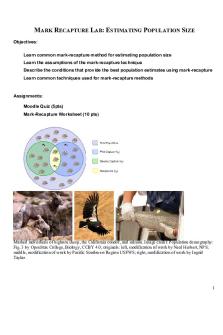Lab 3 Mark and Recapture PDF

| Title | Lab 3 Mark and Recapture |
|---|---|
| Course | Ecology Laboratory |
| Institution | Kennesaw State University |
| Pages | 2 |
| File Size | 48.8 KB |
| File Type | |
| Total Downloads | 43 |
| Total Views | 127 |
Summary
An important step in an ecosystem study is determining population size of the species present. This laboratory includes an exercise in estimating the population size of animals using the "mark-recapture" method...
Description
Josiah Takang Biology 3370L Mark-Recapture Lab This lab was to perform a mark-recapture experiment on the isopods living in a given habitat at Kennesaw State University. The table below shows how many isopods were marked with a special paint across lab sections. It also shows how many isopods lab sections captured, and how many of those displayed a mark (recaptured).
By using the following equation: N=M(C+1)/(R+1), an estimated population size of 131.25 was calculated for the isopods. Certain assumptions had to be met in order for this experiment to be valid. 1. All individuals in the population have an equal chance of being captured. - This assumption was met, because the area used for capturing was fairly reasonable in terms of accessibility, and each group scattered throughout the area captured roughly the same amount of isopods. 2. There is no change in the ratio of marked to unmarked animals between capture times. This means that there have been no significant additions of unmarked individuals to the population and that decreases in the population have affected marked and unmarked individuals proportionally. - Death of ispods between capture times seemed implausible, because the ratio between marked and unmarked individuals was significant. This assumption was met. 3. Marked individuals distribute themselves in the population homogeneously after being released. - This assumption was met in that enough time passed before a recapture event had occurred. All isopods were distributed evenly back into their habitat when released after being captured by each lab section. 4. Capturing and marking an organism does not affect its chances of being recaptured. - By marking the isopods with paint, we made sure to mark them on a discrete part of their back in a dull paint color, making sure the mark wouldn’t attract predators causing death, thus not being able to be recaptured, therefore this assumption was met.
5. Marks are not lost or overlooked. - The paint marks on the isopods seemed to hold up after days of being marked. The paint had faded slightly but it was clear which individuals had been marked previously, and which had not. This assumption was also met. If the fifth assumption was not met, whereas the marks placed on the isopods washed off in the rain, or were not seen by observers, then the calculated population size estimate would be over-estimated. This being because the recaptured value would be lower than how many isopods actually did have a mark on them at one point, causing a higher estimate for population size....
Similar Free PDFs

Lab 3 Mark and Recapture
- 2 Pages

Mark Recapture Background Spring 19
- 13 Pages

Mark up and mark down
- 3 Pages

MARK 4441 - Chapter 3 Notes
- 5 Pages

Exam #3 Review - mark deskovitz
- 1 Pages

MARK Textbook Notes Test 3
- 24 Pages

Eco mark and its importance
- 3 Pages

Forces and Vector - Lab 3
- 6 Pages

3. Mitosis AND Development LAB
- 9 Pages

Mark and spencer and H&M
- 4 Pages
Popular Institutions
- Tinajero National High School - Annex
- Politeknik Caltex Riau
- Yokohama City University
- SGT University
- University of Al-Qadisiyah
- Divine Word College of Vigan
- Techniek College Rotterdam
- Universidade de Santiago
- Universiti Teknologi MARA Cawangan Johor Kampus Pasir Gudang
- Poltekkes Kemenkes Yogyakarta
- Baguio City National High School
- Colegio san marcos
- preparatoria uno
- Centro de Bachillerato Tecnológico Industrial y de Servicios No. 107
- Dalian Maritime University
- Quang Trung Secondary School
- Colegio Tecnológico en Informática
- Corporación Regional de Educación Superior
- Grupo CEDVA
- Dar Al Uloom University
- Centro de Estudios Preuniversitarios de la Universidad Nacional de Ingeniería
- 上智大学
- Aakash International School, Nuna Majara
- San Felipe Neri Catholic School
- Kang Chiao International School - New Taipei City
- Misamis Occidental National High School
- Institución Educativa Escuela Normal Juan Ladrilleros
- Kolehiyo ng Pantukan
- Batanes State College
- Instituto Continental
- Sekolah Menengah Kejuruan Kesehatan Kaltara (Tarakan)
- Colegio de La Inmaculada Concepcion - Cebu





